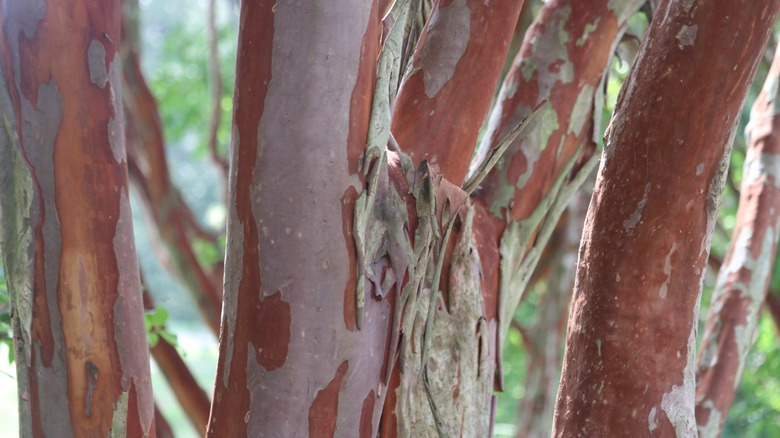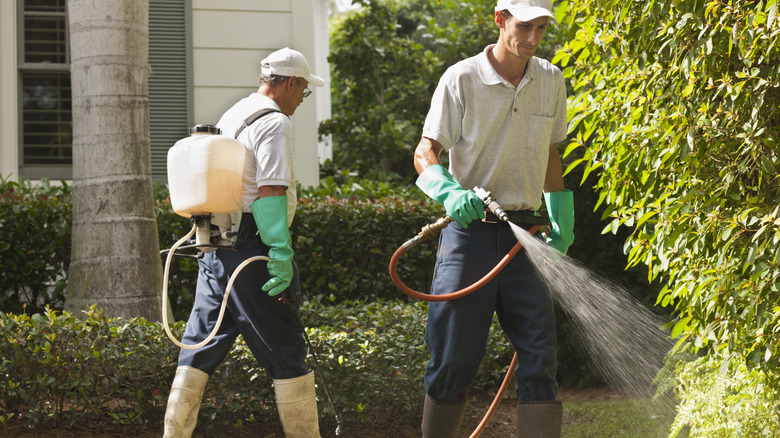White Spots On Your Crepe Myrtle Tree? Here's What It Means & What To Do
Crepe myrtles are attractive choices for a home landscape, with their gorgeous summer-to-fall flowers and pretty evergreen foliage throughout the winter in warmer regions. While they're generally considered tough trees, crepe myrtles require some special care to ensure they are healthy and thriving, including avoiding crepe murder while pruning, and a watchful eye for common crepe myrtle pests. One such pest that is relatively new to the scene in the U.S. is crepe myrtle bark scale, an invasive insect that can quickly turn a lovely crepe myrtle tree into an infested eyesore.
First reported in Texas in 2004, crepe myrtle bark scale has spread to a number of Southern states where crepe myrtles are popular landscape trees, including Georgia, Louisiana, Mississippi, North Carolina, Oklahoma, and Virginia. Infestations of this insect spread quickly among crepe myrtles — even those that are hundreds of feet apart from each other — and as invasive pests, crepe myrtle bark scale populations face few threats from predators in the U.S. While the damage the scale causes to crepe myrtles is primarily aesthetic in nature, crepe myrtles affected by scale may display less vigor and fewer flowers than healthy crepe myrtles. Homeowners would do well to spot the early signs of crepe myrtle bark scale to prevent unsightly white patches and a spread of black, sooty mold on their prized crepe myrtles. If not caught in time, the best treatment is soil-applied insecticide.
How to spot crepe myrtle bark scale
While still alarming, damage to crepe myrtle leaves is not an indicator of crepe myrtle bark scale (though it may point to aphid infestation or disparate crepe myrtle diseases to look out for). As the name implies, crepe myrtle bark scale can be found on the bark of crepe myrtles. Unfortunately, even a close examination of your crepe myrtle's bark may not be enough to catch an infestation at its earliest stages – recently hatched bark scale nymphs, also known as crawlers, are tiny, pink, and difficult to spot. A more obvious visual cue is a black, sooty mold growing on your crepe myrtle's branches and twigs. This mold grows on the honeydew excreted by crepe myrtle bark scale nymphs as they begin feeding on the tree. Sooty mold can also be an indicator of crepe myrtle aphid infestation, so there's one key visual indicator to look out for if you suspect your tree is a victim of crepe myrtle bark scale: white spots on the bark.
What exactly are these white spots? Though their felted, fuzzy coating may make these spots look like lichen or mold, the white spots are actually ovisacs, where adult female bark scale insects deposit their many eggs. You can confirm that these spots are crepe myrtle bark scale by puncturing the scale with a toothpick or crushing the scale. If they are indeed crepe myrtle bark scale, the spots will leak pink blood or pink egg clusters. Gross!
Controlling crepe myrtle bark scale
With 60 to 250 eggs in each white ovisac, and the ability for eggs to overwinter and hatch the following spring, controlling the spread of crepe myrtle bark scale as early as possible is critical. When buying crepe myrtle at your garden store, examine the upper tips and twigs of the plants for signs of scale to prevent bringing an infestation home in the first place. Though research into crepe myrtle bark scale control is still ongoing, the best existing treatment for it is soil-applied insecticide, which should be administered once a year in the early growing season for crepe myrtles. To ensure insecticide applications are as effective as possible, and to reduce the unpleasant appearance of the mold that accompanies crepe myrtle bark scale, scrub tree branches and trunks with a soft brush and a solution of dish soap and water to dislodge the scales and egg clusters. Be sure to check the crotches of your trees where branches meet, as crepe myrtle bark scale is likely to accumulate in those areas.
Also, keep an eye out for other white, fuzzy insects amongst the crepe myrtle bark scale: they may be the larvae of the Hyperaspis lady beetle, which preys on crepe myrtle bark scale. Lady beetle larvae will have a slightly spikier appearance than scale ovisacs. Though they aren't numerous enough to keep up with bark scale infestations in the U.S., lady beetles may be a promising new lead in eventually controlling the scale.


